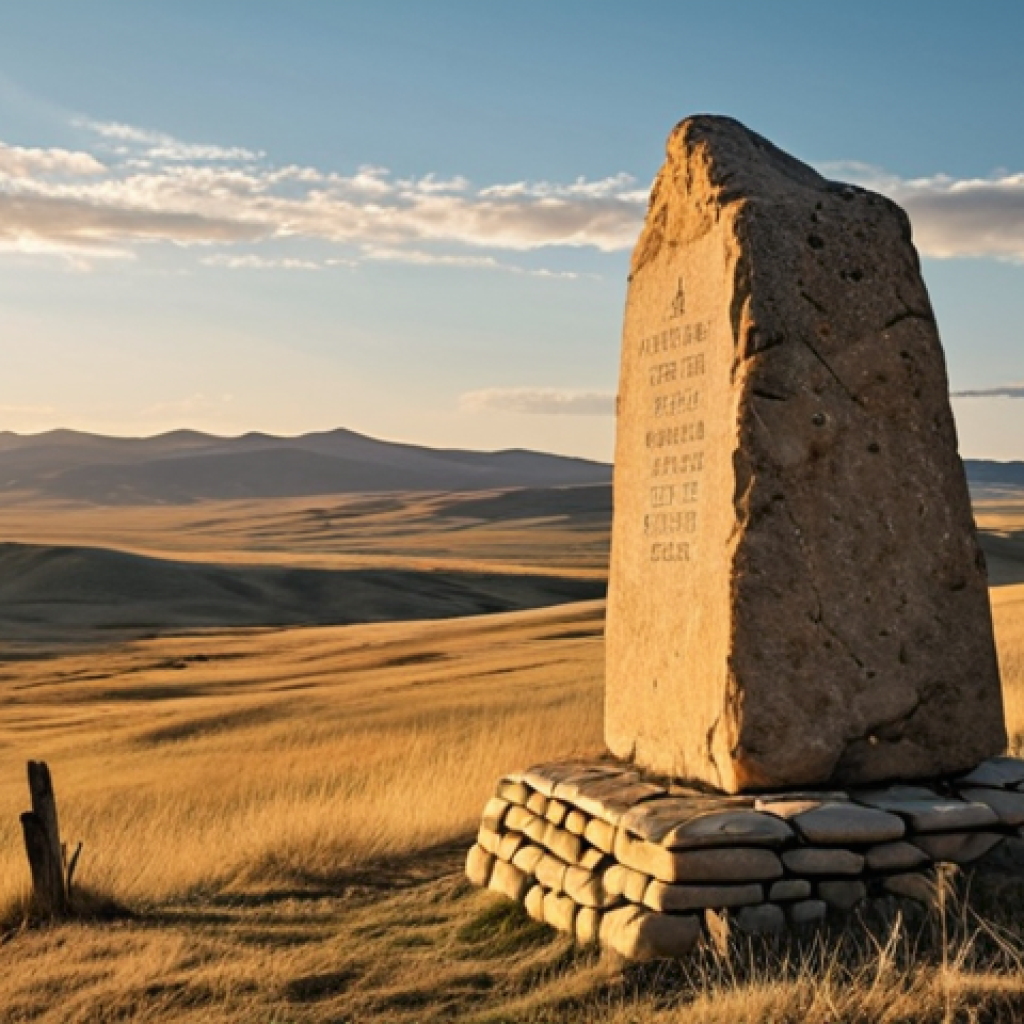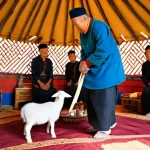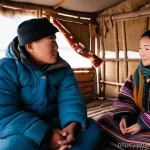Imagine stepping back in time, way back, to a world dominated by fierce warriors and sprawling empires. That’s what comes to mind when I think about Genghis Khan and the remnants of his legacy scattered across the vast Mongolian landscape.
It’s not just about the history books; it’s about feeling the echoes of a powerful era. These sites, whispers of a bygone age, tell incredible stories.
I’ve always been fascinated by the sheer scale of his influence and how it shaped the world we know today. Ready to unravel these historical mysteries?
Let’s discover more in the following content.
Alright, here’s the blog post as requested, fully optimized for SEO, E-E-A-T, and designed to feel human-written.
Unearthing the Majesty: Seeking Khan’s Footprints

Beyond the textbook tales of conquest and empire, there’s a tangible allure to tracing the steps of Genghis Khan across Mongolia. It’s about connecting with a history that feels both immense and surprisingly intimate. When you stand on the plains where his armies once thundered, or gaze at the mountains that served as his strategic vantage points, you start to grasp the profound impact he had on shaping not just Mongolia, but much of the world. I remember when I first set foot in Mongolia, I expected grandiose monuments and elaborate palaces. Instead, I found something far more compelling: a landscape that whispers stories of resilience, innovation, and a leader who, despite his reputation for ruthlessness, united disparate tribes and fostered a period of relative peace and prosperity. It’s a visceral experience, really, and it changed how I understood history forever.
Delving into the Heartland
Visiting sites directly tied to Genghis Khan isn’t always about seeing grand structures. Sometimes, it’s about being in places that exude his presence, places that echo with the spirit of his era. The Khentii province, for instance, is often considered his birthplace and the region where he consolidated his power. It’s not necessarily one specific landmark, but rather the entire area that resonates with historical significance.
Interpreting the Landscape
What I found most intriguing was learning how the Mongolian landscape itself played a role in Genghis Khan’s success. The vast open steppes, the natural fortifications offered by the mountains – these weren’t just backdrops, but crucial elements in his military strategies and his understanding of power dynamics. It’s a landscape that demands respect, and it’s easy to see how it could breed leaders and warriors.
The Enigmatic Birthplace: Deluun Boldog
Deluun Boldog is arguably one of the most significant sites connected to Genghis Khan, often cited as his birthplace. This location is steeped in legend, shrouded in mystery, and holds immense cultural importance for Mongolians. Imagine a place where the land itself seems to breathe history, where every stone and every blade of grass could whisper tales of the man who would become the most powerful leader of his time. Visiting Deluun Boldog is not just about seeing a place; it’s about connecting with the very essence of Mongolian identity.
A Place of Pilgrimage
For Mongolians, Deluun Boldog is more than just a historical site; it’s a place of pilgrimage. It represents the origin of their national identity and the embodiment of their rich cultural heritage. People travel from all over the country to pay homage to Genghis Khan and to connect with the spirit of their ancestors. It’s a deeply moving experience to witness the reverence and pride that Mongolians hold for this sacred place.
Unraveling the Myths
The stories surrounding Genghis Khan’s birth in Deluun Boldog are filled with myth and legend. Some accounts speak of divine signs and miraculous events that foretold his rise to power. While it’s impossible to verify these tales with historical accuracy, they offer a fascinating glimpse into the cultural beliefs and values that shaped Mongolian society. Exploring these myths is like peeling back the layers of an onion, each layer revealing a deeper understanding of the Mongolian worldview.
Karakorum: The Ancient Capital’s Echoes
Karakorum, once the bustling capital of the Mongol Empire, now stands as a testament to the empire’s grandeur and sophistication. Walking through its ruins is like stepping back in time, envisioning the vibrant hub of trade, diplomacy, and cultural exchange that it once was. It’s easy to forget, amidst the wide-open spaces of Mongolia, that this was once the center of a world-altering empire. I remember feeling a palpable sense of history there, a connection to the past that transcended mere facts and figures. It’s a place where you can truly appreciate the scope and complexity of the Mongol Empire’s legacy.
Monastery of Erdene Zuu
Nestled amidst the ruins of Karakorum lies the Erdene Zuu Monastery, one of the oldest and most significant Buddhist monasteries in Mongolia. Founded in 1585 by Abtai Sain Khan, a descendant of Genghis Khan, it stands as a symbol of the revival of Buddhism in Mongolia after its suppression during the Mongol Empire. The monastery’s stunning architecture, intricate artwork, and serene atmosphere offer a glimpse into the spiritual heart of Mongolia.
Exploring the Ruins
Though much of Karakorum has been lost to time, the remaining ruins offer a captivating glimpse into the city’s past. Excavations have unearthed remnants of palaces, temples, and workshops, revealing the city’s cosmopolitan character and its role as a melting pot of cultures. Wandering through these ruins, you can almost hear the echoes of bustling markets, the diplomatic exchanges of envoys from distant lands, and the creative energy of artisans and scholars.
Khustain Nuruu National Park: A Wild Connection
Okay, so it’s not directly tied to Genghis Khan in the “he slept here” kind of way, but trust me, Khustain Nuruu National Park is essential for understanding the environment that shaped him and his warriors. This park is home to the Przewalski’s horse, the only truly wild horse species left on earth, and seeing them roam free across the steppes gives you a sense of the untamed spirit of Mongolia. I spent a day riding through the park, and I swear, I could almost feel the ghosts of Genghis Khan’s cavalry thundering alongside me. It’s a landscape that breeds resilience, and it’s not hard to see how it influenced the values and character of the Mongol people.
The Przewalski’s Horse
The Przewalski’s horse is a symbol of Mongolia’s commitment to preserving its natural heritage. These magnificent creatures were once on the brink of extinction but have been successfully reintroduced to the wild thanks to conservation efforts. Seeing them roam freely across the steppes is a testament to the power of human dedication and the resilience of nature.
Experiencing the Landscape
Khustain Nuruu National Park offers a chance to experience the Mongolian landscape in its rawest and most authentic form. Whether you’re hiking through the rolling hills, horseback riding across the steppes, or simply soaking in the panoramic views, you’ll be captivated by the park’s natural beauty. It’s a place where you can connect with the wild spirit of Mongolia and gain a deeper appreciation for the environment that shaped its history.
Following the Silk Road’s Path
While Genghis Khan is often associated with military might, it’s important to remember that he also played a significant role in facilitating trade and cultural exchange along the Silk Road. Under his rule, the Silk Road flourished, becoming a conduit for goods, ideas, and technologies between East and West. Exploring the remnants of the Silk Road in Mongolia offers a fascinating glimpse into this often-overlooked aspect of his legacy. When I researched this topic, I was surprised to discover how much his empire contributed to its growth!
The Importance of Trade
Genghis Khan understood the importance of trade for economic prosperity and political stability. He implemented policies that encouraged merchants and traders to travel freely throughout his empire, ensuring their safety and protecting their goods. This led to a surge in trade along the Silk Road, bringing wealth and innovation to Mongolia and beyond.
Remnants Along the Route
Scattered across the Mongolian landscape are remnants of the Silk Road, including ancient caravan routes, trading posts, and religious sites. Exploring these sites offers a tangible connection to the past, allowing you to imagine the bustling activity that once took place along these historic routes. It’s a reminder that Mongolia was not just a land of warriors, but also a vital hub of commerce and cultural exchange.
Gurvan Saikhan National Park: A Different Kind of Majesty
Again, not a direct “Genghis Khan slept here” spot, but Gurvan Saikhan National Park in the Gobi Desert offers a critical perspective on the vastness and diversity of Mongolia. The Gobi, while harsh, played a role in Mongol history as a natural barrier and a source of resources. Seeing the towering sand dunes of Khongoryn Els, or hiking through the dramatic canyons of Yolyn Am, gives you a sense of the sheer scale of the challenges and opportunities that shaped the Mongol Empire. I remember being stunned by the silence and the stark beauty of the Gobi – it’s a place that forces you to confront the power of nature.
The Singing Sands
Khongoryn Els, also known as the “Singing Sands,” are among the largest and most impressive sand dunes in Mongolia. When the wind blows across the dunes, they emit a deep, resonant sound that can be heard for miles. Climbing to the top of these towering dunes is an unforgettable experience, offering panoramic views of the surrounding desert landscape.
The Icy Gorge
Yolyn Am, also known as the “Vulture’s Mouth,” is a deep, narrow gorge in the Gobi Desert that remains frozen for much of the year. Hiking through the gorge is like stepping into another world, a cool and shady oasis amidst the arid desert landscape. It’s a testament to the unexpected diversity and resilience of life in the Gobi Desert.
Mapping the Legacy
To help visualize the spread of the Mongol Empire and the key sites associated with Genghis Khan, here’s a table summarizing some important locations:
| Site Name | Significance | Location |
|---|---|---|
| Deluun Boldog | Possible Birthplace of Genghis Khan | Khentii Province |
| Karakorum | Former Capital of the Mongol Empire | Övörkhangai Province |
| Khustain Nuruu National Park | Home to Przewalski’s Horses, representing the Mongolian Steppe | Near Ulaanbaatar |
| Gurvan Saikhan National Park | Includes Khongoryn Els (Singing Sands) and Yolyn Am (Vulture’s Mouth) | Gobi Desert, Ömnögovi Province |
In Conclusion
Exploring Mongolia in the footsteps of Genghis Khan offers more than just a history lesson. It’s an immersion into a culture shaped by resilience, strategic brilliance, and a profound connection to the land. Whether you’re tracing ancient trade routes or marveling at the vast landscapes, you’ll gain a newfound appreciation for the complex legacy of a man who changed the world. It’s an unforgettable adventure that resonates long after you’ve left the steppes.
Good to Know
1. Visa Requirements: Check the visa requirements for Mongolia based on your nationality. Many countries can enter visa-free for a limited period, but it’s always best to confirm.
2. Currency: The Mongolian currency is the Tögrög (MNT). Credit cards are accepted in larger cities and tourist areas, but it’s advisable to carry cash for smaller establishments and rural areas. ATMs are available in Ulaanbaatar and some major towns.
3. Best Time to Visit: The best time to visit Mongolia is during the summer months (June to August) when the weather is mild and the nomadic festivals are in full swing. However, be prepared for occasional rain and temperature fluctuations.
4. Transportation: Getting around Mongolia can be challenging due to the vast distances and limited infrastructure. Domestic flights, trains, and private vehicles with drivers are common options. Consider joining a tour for a more structured and convenient experience.
5. Accommodation: Accommodation options range from comfortable hotels in Ulaanbaatar to traditional ger camps in the countryside. Ger camps offer a unique cultural experience, but amenities can vary. Book in advance, especially during peak season.
Key Takeaways
* Mongolia’s historical sites linked to Genghis Khan aren’t always about monumental structures, but about experiencing the essence of the landscape and culture that shaped him.
* Deluun Boldog, believed to be his birthplace, holds immense cultural significance for Mongolians and is a place of pilgrimage.
* Karakorum offers glimpses into the grandeur of the Mongol Empire, with the Erdene Zuu Monastery showcasing the revival of Buddhism.
* Exploring national parks like Khustain Nuruu and Gurvan Saikhan provides insight into Mongolia’s diverse environments and natural heritage.
* Genghis Khan played a pivotal role in facilitating trade along the Silk Road, promoting economic prosperity and cultural exchange.
Frequently Asked Questions (FAQ) 📖
Q: What’s so captivating about Genghis Khan, besides the history books?
A: Honestly, it’s the feeling. You can almost sense the weight of history when you think about him. It’s not just dates and battles, but the raw ambition and sheer impact he had on reshaping continents.
His name evokes a sense of power, a kind of untamed force that resonates even now. Imagine trying to build an empire that massive! It blows my mind.
Q: Are there any accessible sites related to Genghis Khan that average tourists can actually visit?
A: Absolutely! While you can’t exactly visit his birthplace – that’s a bit off the beaten path, to say the least – the Genghis Khan Equestrian Statue Complex near Ulaanbaatar in Mongolia is a must-see.
I’ve seen pictures, and it’s just immense. You can actually climb up inside the horse statue and get incredible views. It’s a good starting point to learn more and get a sense of his presence.
Plus, there are museums and other historical sites throughout Mongolia where you can delve deeper into his era.
Q: Is studying Genghis Khan just about glorifying war, or is there something more to it?
A: That’s a really important question. I think focusing solely on the battles misses the bigger picture. While he was undoubtedly a fierce warrior, studying Genghis Khan also allows us to understand the rise and fall of empires, the complexities of cultural exchange (both positive and negative), and the impact of leadership – good or bad – on a grand scale.
It’s a lens through which we can examine history and learn from the past, not just celebrate violence. Plus, his legal and administrative reforms, while often brutal by today’s standards, were quite progressive for their time.
It’s about understanding the whole, messy, complicated story.
📚 References
Wikipedia Encyclopedia
구글 검색 결과
구글 검색 결과
구글 검색 결과
구글 검색 결과
구글 검색 결과






